And start earning money 💸 by teaching English in your own country, abroad, or online from anywhere on the planet! 🎁 Gifts and bonuses: professional support from your personal coach 🧑🏫 and job placement assistant 💼.

How to Teach Small Talk in an English Class
Table of contents
The Importance of Small Talk in English-Speaking Society
Small talk plays a vital role in English-speaking societies. It is the grease that keeps the social wheels turning, allowing people to connect, build rapport, and navigate social situations smoothly. Whether it's a casual conversation with a colleague in the break room, a brief chat with a neighbour, or an exchange with a stranger while waiting in line, small talk helps to establish connections and foster a sense of community.
For English learners, mastering the art of small talk is crucial. It not only improves their language skills but also boosts their confidence in social interactions. However, one of the significant challenges for learners is summarizing big thoughts into concise, relevant responses—a skill that requires practice and understanding of cultural nuances.
Challenges of Summarizing Big Thoughts into Short Answers
Many English learners struggle with the brevity and spontaneity required in small talk. Unlike structured, longer conversations, small talk demands quick thinking and the ability to convey thoughts succinctly. Learners often find it challenging to strike the right balance between being too terse and over-explaining. The key is to practice responding to common topics and questions in a way that feels natural and engaging.
Situations Where Small Talk is Required
Social Gatherings: Events like parties, networking functions, and informal meet-ups often begin with small talk to break the ice.
Workplace Interactions: Casual conversations with colleagues in the break room, before meetings, or during work events.
Public Places: Brief exchanges with strangers in places like parks, cafes, or public transportation.
Service Encounters: Interactions with service personnel, such as cashiers, waitstaff, or receptionists.
💡 Unlock the secrets to doubling your teaching income with our exclusive checklist! 🎯 This checklist is designed for English teachers who want to 📈 attract more students and 🔥 keep them engaged for the long term.
Examples of Small Talk
Weather:
Person A: "It's a beautiful day, isn't it?"
Person B: "Absolutely, it's perfect for a walk in the park."
Work:
Person A: "How's your project coming along?"
Person B: "It's going well, just wrapping up the final touches."
Hobbies:
Person A: "What do you like to do in your free time?"
Person B: "I enjoy reading and hiking. How about you?"
Travel:
Person A: "Have you traveled anywhere interesting lately?"
Person B: "Yes, I visited Italy last month. The food was amazing!"
Compliments:
Person A: "I like your jacket, where did you get it?"
Person B: "Thanks! I got it at a local boutique downtown."
Activities to Teach and Practice Small Talk in English Classes
Role-Playing Scenarios:
Activity: Create various scenarios where students must engage in small talk, such as meeting a new colleague, attending a party, or waiting in line at a coffee shop.
Objective: To practice spontaneous conversations and appropriate responses.
Example: Pair students and give each pair a scenario card. Have them role-play the conversation for a few minutes, then switch partners and scenarios.
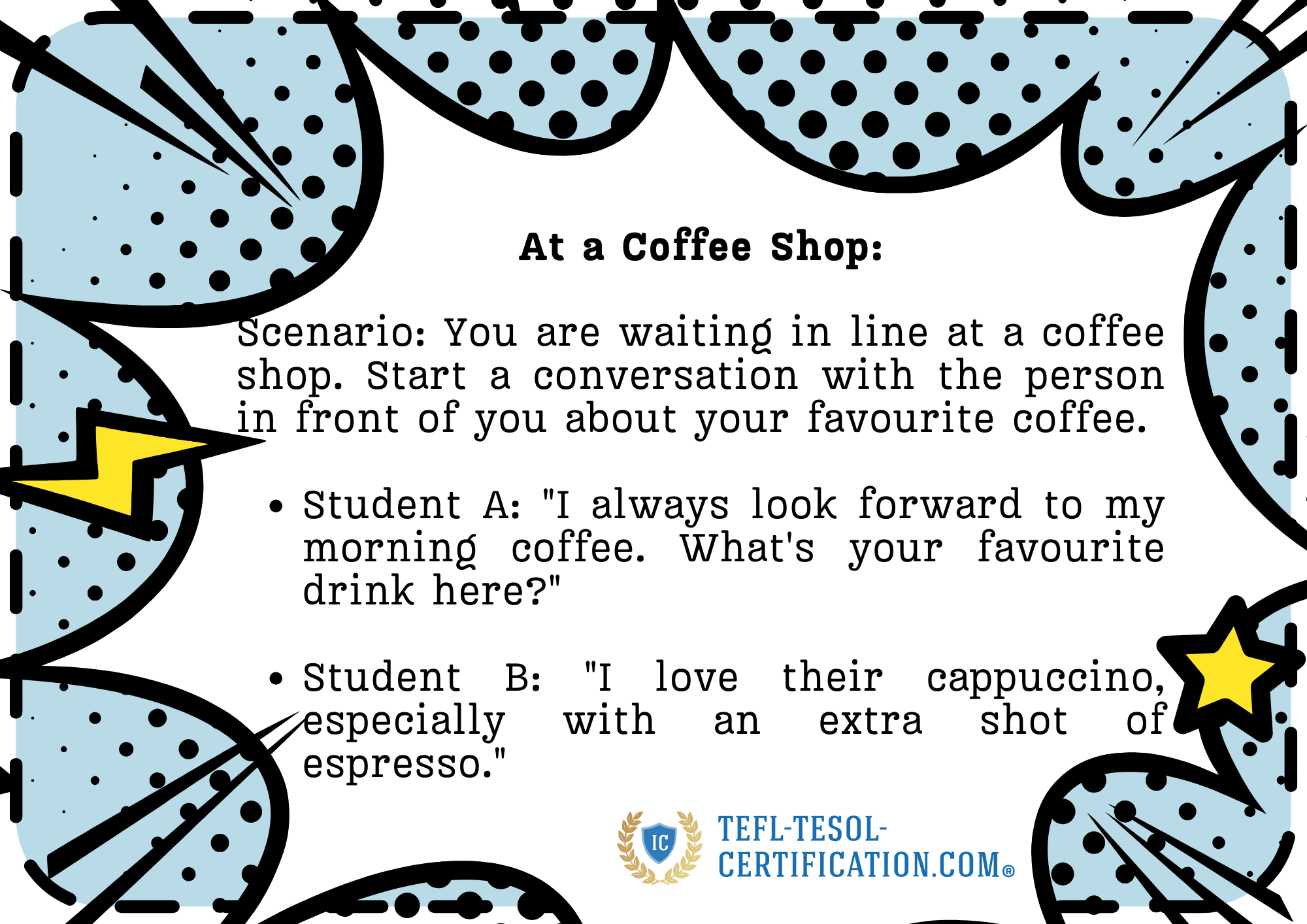
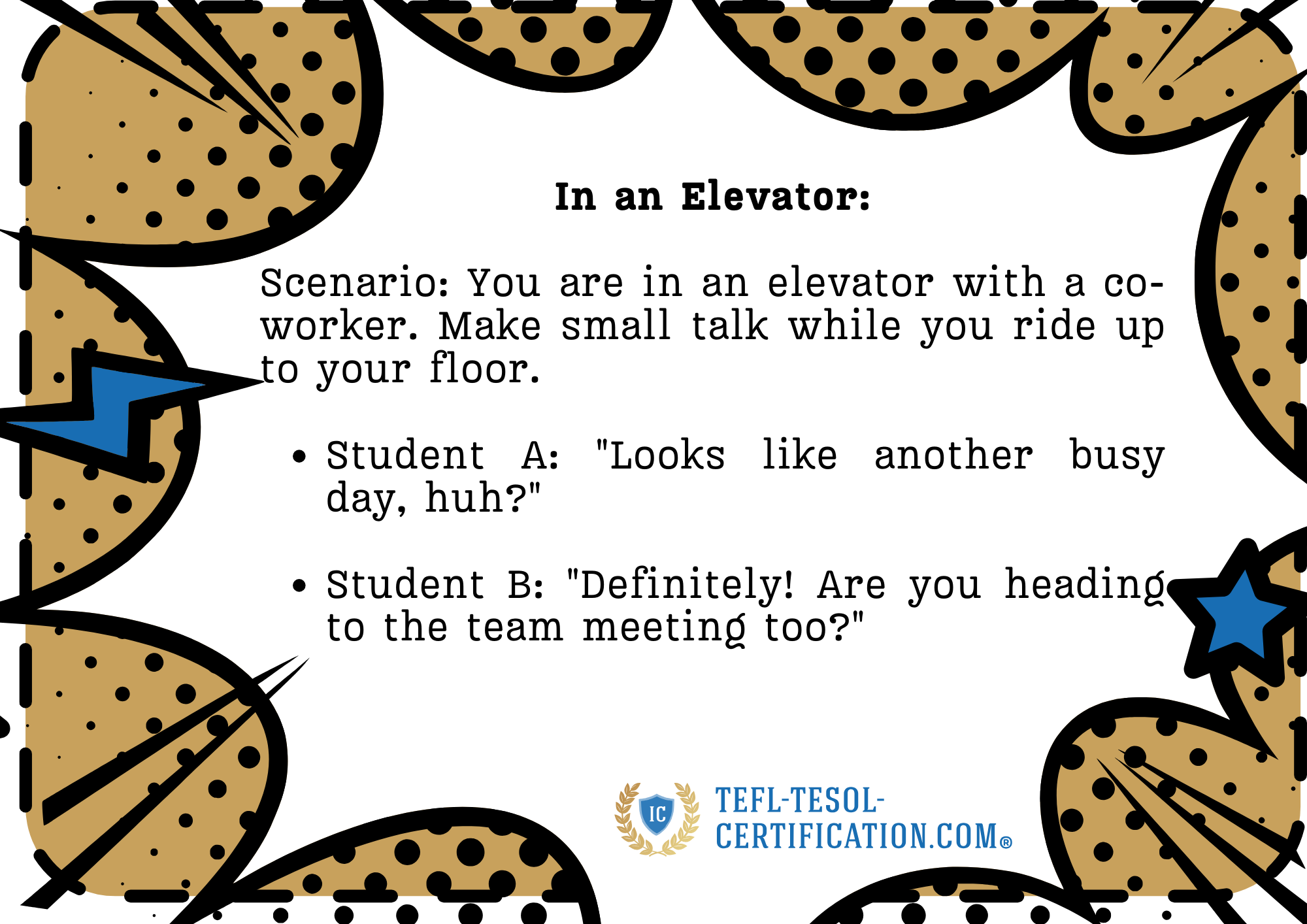
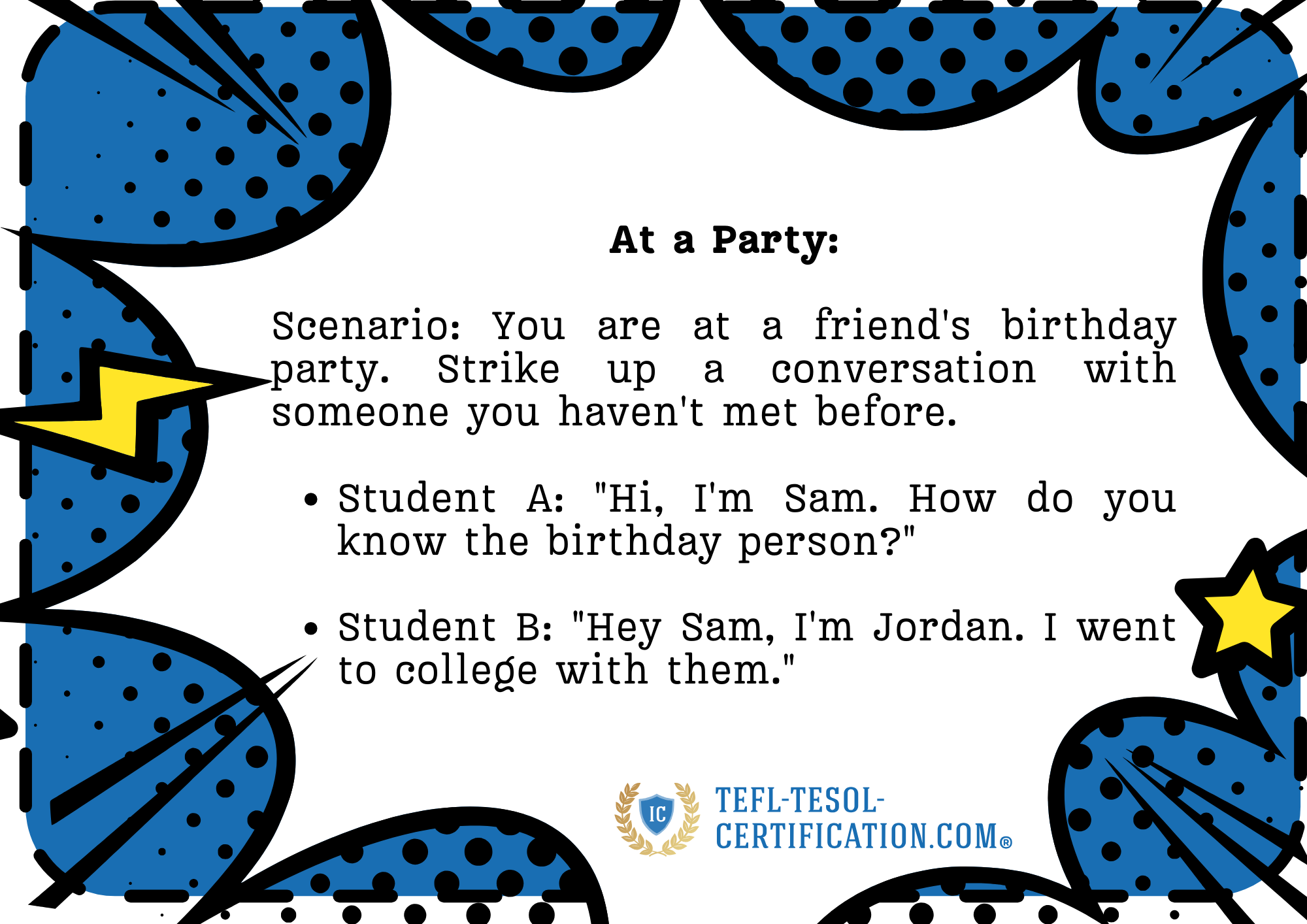

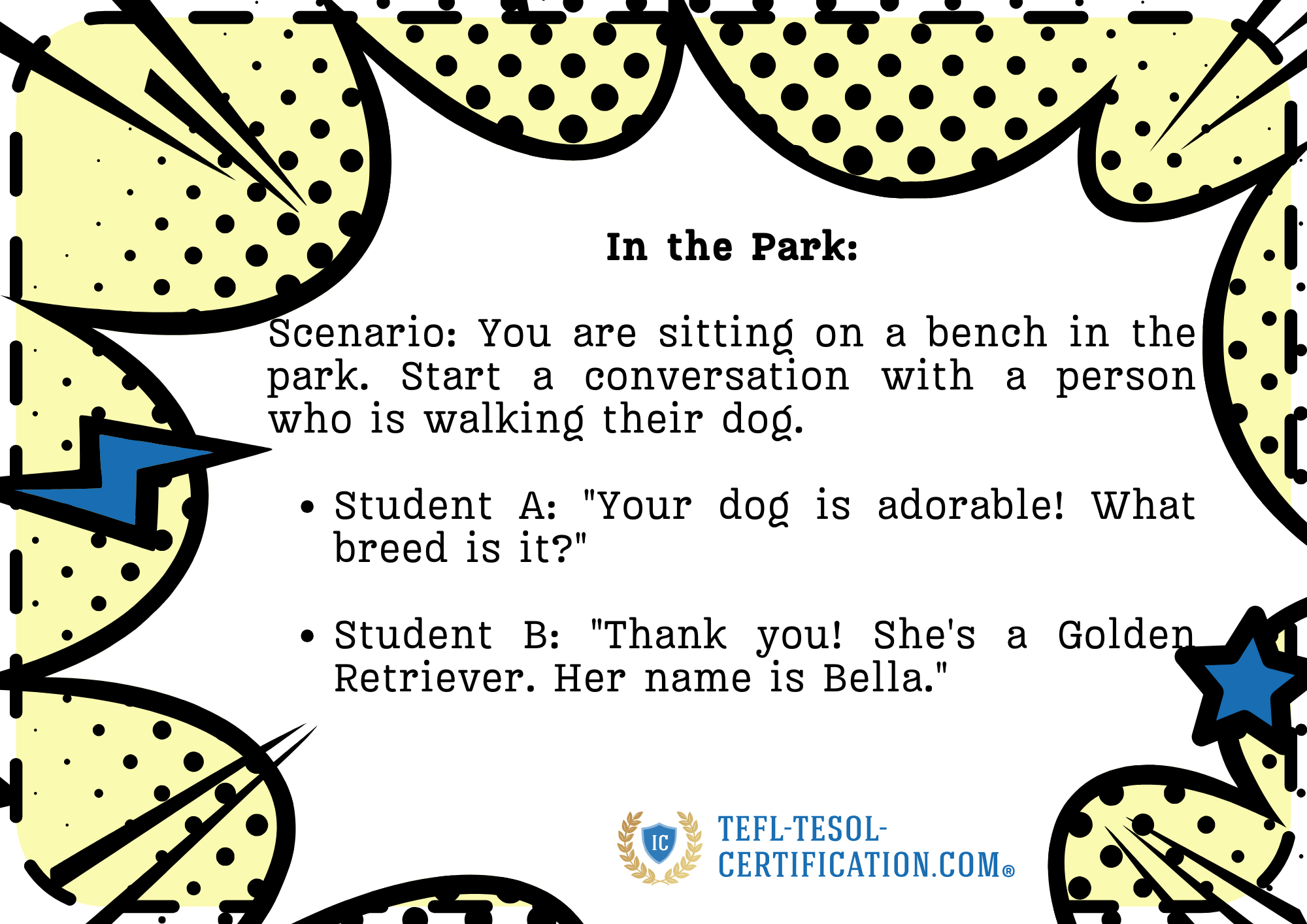
Conversation Starters:
Activity: Provide students with a list of common conversation starters and have them practice initiating conversations.
Objective: To develop confidence in starting small talk.
Example: In groups of three, one student picks a conversation starter, the second responds, and the third observes and provides feedback. Rotate roles.
Common Conversation Starters
"How was your weekend?"
"Did you see the game last night?"
"Have you been to any good restaurants lately?"
"What do you do for fun?"
"Any plans for the upcoming holiday?"
"Have you read any good books recently?"
"What kind of music do you like?"
"Do you enjoy traveling? Where's the best place you've visited?"
"How long have you been working here?"
"What's your favourite thing to do in the city?"
Speed Chatting:
Activity: Organize a speed dating-style activity where students have short, timed conversations with multiple partners.
Objective: To practice quick exchanges and adaptability in conversations.
Example: Set up a timer for 2-3 minutes per conversation. After the time is up, students rotate to a new partner and start a new conversation on a different topic.
Small Talk Bingo:
Activity: Create bingo cards with different small talk topics or questions. Students must find classmates who can talk about each topic.
Objective: To encourage interaction and diverse conversations.
Example: Topics might include "Talk about your favourite movie," "Discuss the weather," or "Share a travel experience." Students mingle and mark off topics as they discuss them with different classmates.
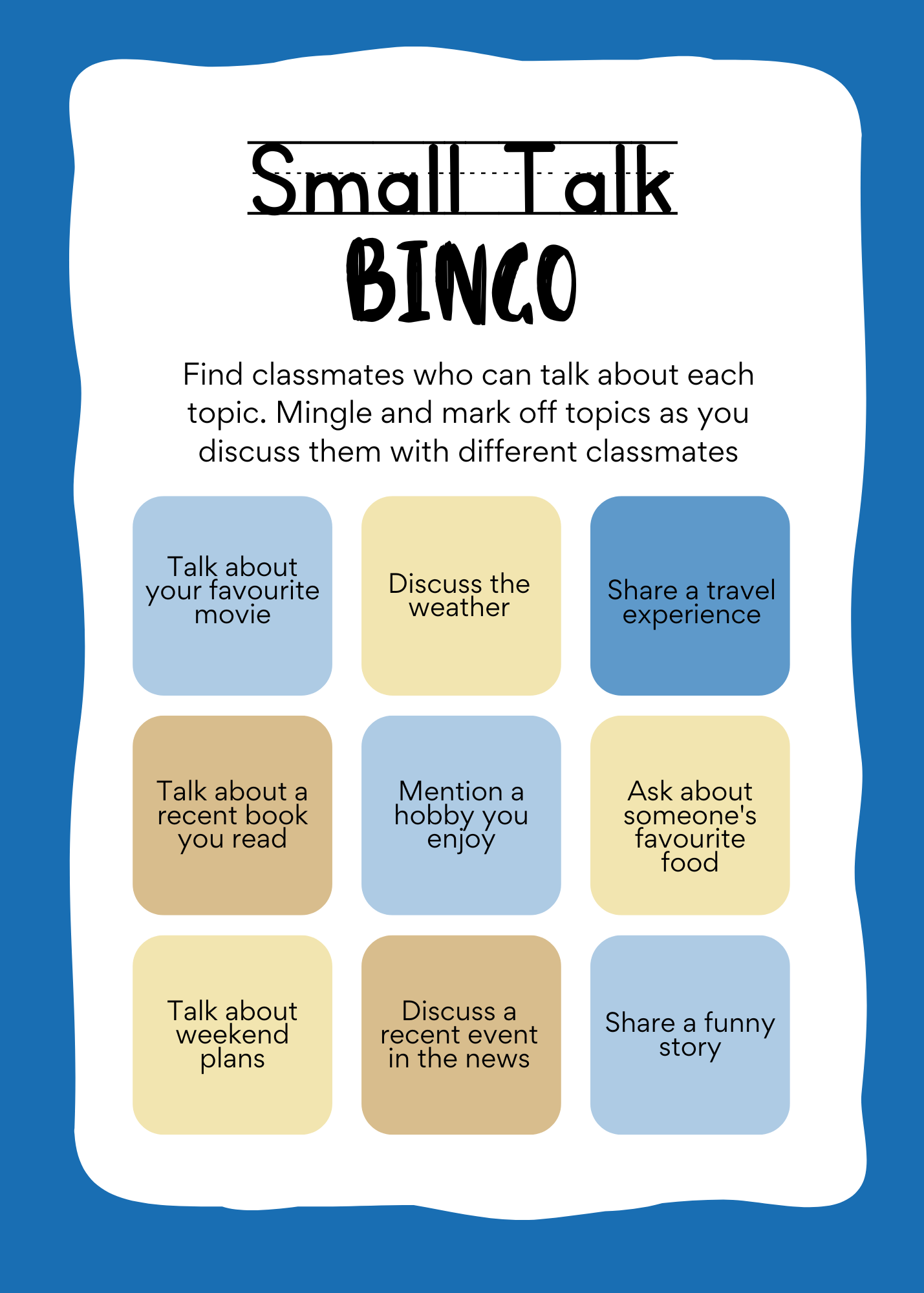
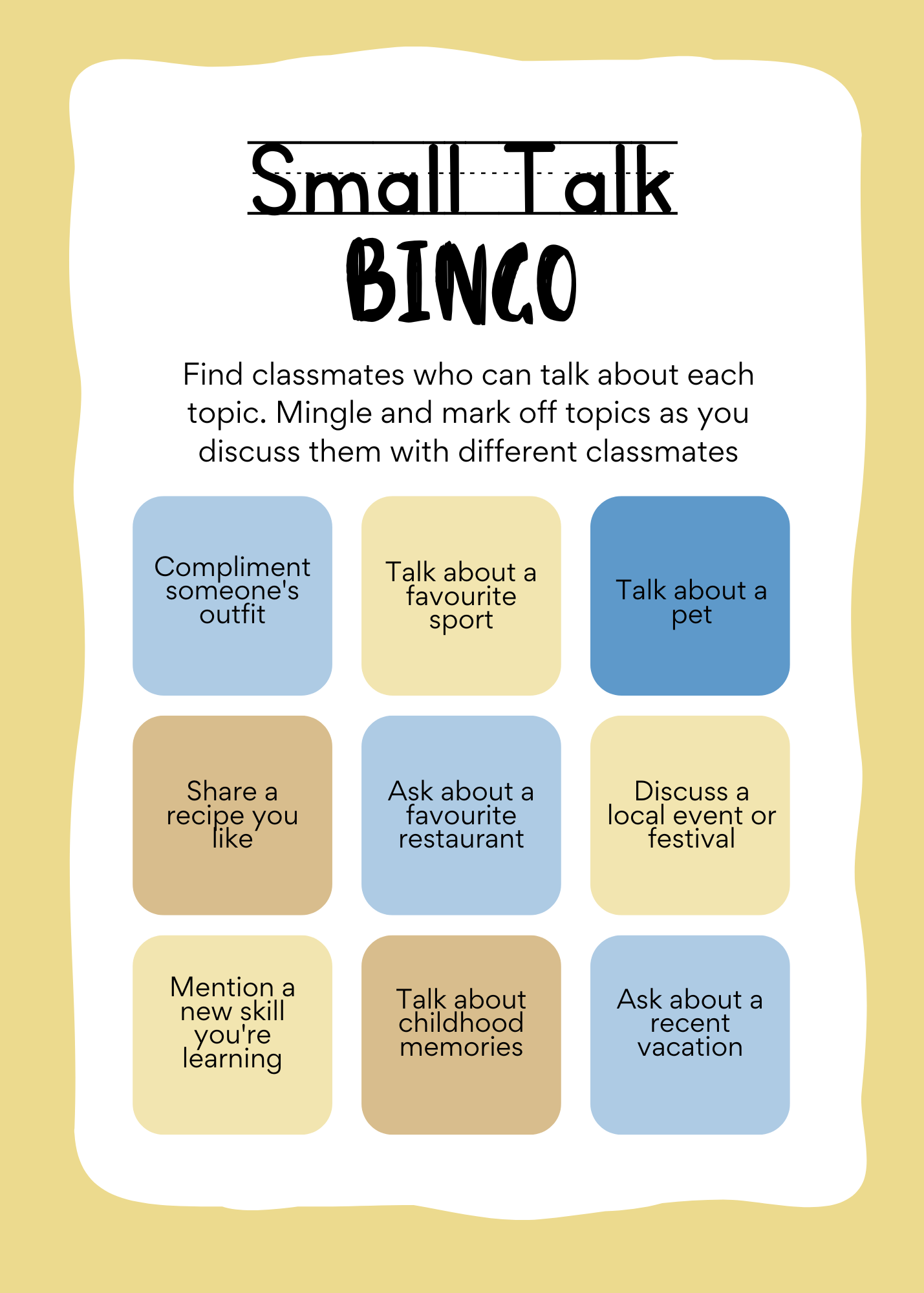
Conversation Jigsaw:
Activity: Divide a story or conversation into parts and distribute them to different students. Students must find their counterparts to complete the conversation.
Objective: To practice piecing together coherent conversations from fragments.
Example: Give each student a slip of paper with a sentence or question. Students walk around, find the sequence, and reconstruct the conversation.
Story or Conversation Divided into Parts
Story: "Planning a Surprise Party"
Part 1:
Student A: "Hey, are you free this weekend? I need some help with something."
Student B: "Sure, what's up?"
Part 2:
Student A: "It's Sarah's birthday, and I'm planning a surprise party for her."
Student B: "That sounds great! What do you need help with?"
Part 3:
Student A: "I need help with the decorations and maybe some ideas for games."
Student B: "I'd love to help! We could do a trivia game about Sarah's favourite things."
Part 4:
Student A: "Perfect! And do you think you could bring some snacks?"
Student B: "Absolutely, I'll bring some chips and dip. This is going to be so much fun!"
By incorporating these activities into English classes, teachers can create dynamic and engaging opportunities for students to practice small talk. These exercises not only improve language skills but also help students build the confidence needed to navigate social situations in English-speaking environments.
🚀 More students, 💰 higher income, 🌍 complete freedom! ✅ 112 verified platforms with top rates ⏳ Flexible schedule – work whenever and as much as you want 🎯 Simple requirements – start earning right away 💎 Boost your career and income by teaching students worldwide!
Conclusion. The Importance of TEFL and TESOL Certification.
Teaching English effectively requires more than just language Prociency; it demands an understanding of cultural nuances, modern teaching techniques, and the ability to tailor lessons to the needs of different age groups and goals. Obtaining a TEFL (Teaching English as a Foreign Language) or TESOL (Teaching English to Speakers of Other Languages) certification equips educators with these essential skills. These certifications provide comprehensive training in communication strategies, lesson planning, and classroom management, ensuring that teachers can create engaging and effective learning experiences. By being TEFL or TESOL certified, teachers are better prepared to help learners navigate the complexities of small talk and other conversational skills, fostering their confidence and competence in English-speaking environments.
Terms used:
TEFL, TESOL

York Fern
An English instructor with 12+ years of experience. I work for an online school and travel the world, teaching students from various countries, leveraging my TEFL/TESOL certification. Seeing the world's oceans, mountains, and cities with my own eyes has given me a profound appreciation for the importance of quality education and international communication.
and start earning by teaching English in your country, abroad, or online from anywhere in the world! Order the course with a 50% discount 💸 and receive as a gift the support of a personal coach 👨🏫 and job placement assistant! 🎁🚀 Hurry, limited spots available! 🏃♂️💨
💡 Unlock the secrets to doubling your teaching income with our exclusive checklist! 🎯 This checklist is designed for English teachers who want to 📈 attract more students and 🔥 keep them engaged for the long term.
🚀 More students, 💰 higher income, 🌍 complete freedom! ✅ 112 verified platforms with top rates ⏳ Flexible schedule – work whenever and as much as you want 🎯 Simple requirements – start earning right away 💎 Boost your career and income by teaching students worldwide!
choose us?



